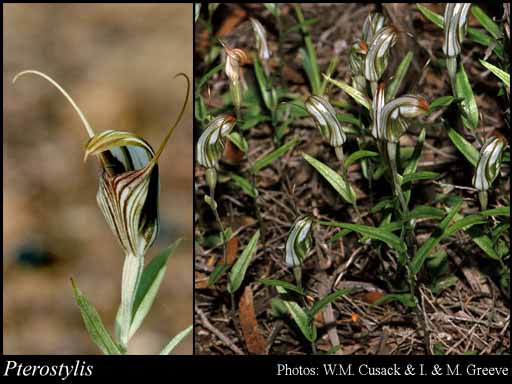- Reference
- Prodr.Fl.Nov.Holland. 326 (1810)
- Name Status
- Current







Scientific Description
Family Orchidaceae.
Habit and leaf form. Herbs; deciduous. Plants succulent, or non-succulent. Perennial. Leaves basal (broad, often petiolate), or cauline (often narrowly ovate), or basal and cauline. Plants with a basal concentration of leaves, or with neither basal nor terminal concentrations of leaves (the rosette encircling the base of the flowering stem; in some species a rosette may be present only in non-flowering plants, while in flowering plants the leaves are found scattered up the stem); tuberous (tubers fleshy, rounded). Helophytic, or mesophytic. Leaves small to medium-sized; alternate, or opposite, or whorled; ‘herbaceous’, or leathery, or fleshy; imbricate, or not imbricate; petiolate; simple. Leaf blades entire; flat; parallel-veined; cross-venulate, or without cross-venules. Leaf blade margins entire. Vernation conduplicate. Leaf anatomy. Hairs absent. Stem anatomy. Secondary thickening absent.
Reproductive type, pollination. Fertile flowers hermaphrodite. Unisexual flowers absent. Plants hermaphrodite. Entomophilous (small gnats and mosquitoes), or pollinated by unusual means (self-pollinated). Pollination mechanism conspicuously specialized (insects become trapped in the vicinity of the column, or are forced against it by the irritable labellum which flicks back when touched. The column wings then provide an escape tunnel, first past the stigma, then the anthers).
Inflorescence and flower features. Flowers solitary, or aggregated in ‘inflorescences’. Inflorescence few-flowered to many-flowered. Flowers in racemes (loose). The terminal inflorescence unit racemose. Inflorescences scapiflorous, or not scapiflorous; terminal. Flowers medium-sized to large; odourless; very irregular; zygomorphic; resupinate. The floral asymmetry involving the perianth and involving the androecium. Flowers 3 merous; cyclic; supposedly basically pentacyclic. Perigone tube absent. Perianth of ‘tepals’, or with distinct calyx and corolla; 6, or 4 (by misinterpretation); 2 -whorled; isomerous (but zygomorphic); joined; green, or red to brown (banded with translucent white). Calyx (if the outer whorl be so designated) 3 (the median member ostensibly posterior); 1 -whorled; partially gamosepalous. Corolla (i.e. the members of the inner whorl) 3; imbricate. Androecium 3, or 1 (by misinterpretation). Androecial members adnate (the labellum claw joined to a basal extension of the column); united with the gynoecium (fused with the style to form a column or ‘gynostemium’; column concealed within the galea, elongate); coherent (via the gynostemium); 1 - adelphous; theoretically 2 -whorled. Androecium including staminodes, or exclusively of fertile stamens (by misinterpretation). Staminodes 2 (these anterior (ostensibly posterior), supposedly the abaxial pair of the inner whorl). Stamens 1 (this across the flower from the labellum, i.e. anterior but ostensibly posterior, supposedly representing the outer whorl); reduced in number relative to the adjacent perianth; alterniperianthial (i.e. with reference to the single stamen, across the flower from the labellum); filantherous, or with sessile anthers. Anthers dorsifixed to basifixed; dehiscing via longitudinal slits; introrse; tetrasporangiate; appendaged, or unappendaged. Pollen shed in aggregates; in the form of pollinia (pollinia 4). Gynoecium 3 carpelled. The pistil 1 celled. Carpels isomerous with the perianth. Gynoecium syncarpous; eu-syncarpous; inferior. Ovary unilocular; 1 locular. The ‘odd’ carpel anterior (away from the labellum). Gynoecium stylate. Styles 1 (inflexed); apical. Stigmas 1; 3 - lobed (but becoming much modified in form, the apex of the median lobe forming the ‘rostellum’); wet type; papillate; Group III type. Placentation parietal. Ovules not differentiated; in the single cavity 30–100 (i.e. very numerous); non-arillate; anatropous.
Fruit and seed features. Fruit non-fleshy; dehiscent; a capsule. Capsules septicidal, or loculicidal. Fruit 30–500 seeded (i.e. seeds usually very numerous). Seeds endospermic (endosperm development arrested very early), or non-endospermic; minute; without starch. Embryo rudimentary at the time of seed release, or weakly differentiated. Seedling. Seedling collar not conspicuous. Primary root ephemeral.
Additional characters Perianth of 5 dissimilar members and the median inner member modified into the labellum (adaxial sepal arched and adnate at the base to the lateral petals, the 3 segments forminga hood known as the ‘galea’; galea with 1(-2) openings at the front; lateral sepals partially connate to form a lower lip, often forming slender tails; labellum often protruding through a front opening in the galea, attached by a movable claw, small, sometimes with an elongate basal appendage). Leaves not solitary (2–20). Column prominently winged (wings broad, near top of column). Labellum insect-like, or not insect-like. Labellum motile. Perianth not glossy.
Taxonomic Literature
- Wheeler, Judy; Marchant, Neville; Lewington, Margaret; Graham, Lorraine 2002. Flora of the south west, Bunbury, Augusta, Denmark. Volume 1, introduction, keys, ferns to monocotyledons. Australian Biological Resources Study.. Canberra..
- Hopper, Stephen D.; Brown, Andrew P. 2001. Contributions to Western Australian orchidology. 1, history of early collections, taxonomic concepts and key to genera.
- Brown, Andrew; Hoffman, Noel 1995. Orchids of south-west Australia. University of W.A. Press.. Nedlands, W.A..